|
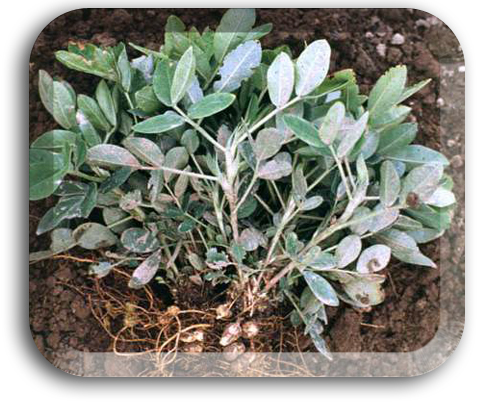
Irrigated
GROUNDNUT (Arachis hypogaea )
I. SEASON AND VARIETIES
DISTRICT / SEASON VARIETIES
A. Rainfed
1. Chithiraipattam (Apr - May)
Pollachi, Theni and TMV 7, ALR 3
Tenkasi
2. Early Adipattam (Jun - Jul)
| All districts |
Bunch : TMV 7, CO 2, VRI 2, VRIGn 5,
Semispreading : TMV 10, COGn 5 |
- Late Adipattam (Jul - Aug)
All districts |
TMV 7, VRI 2, CO 2 |
B. Irrigated
1. Margazhipattam (Dec - Jan)
All districts TMV 7, CO 2, CO 3, COGn 4,
VRI 2, VRI 3, ALR 3, VRIGn 5
2. Masipattam (Feb - Mar)
(New Delta areas of Thanjavur, TMV 7, CO 2, VRI 2, VRI 3, Tiruvarur, Nagapattinam)
3. Chithiraipattam (Apr – May)) TMV 7, CO 2, CO 3, COGn 4,
VRI 2, VRI 3
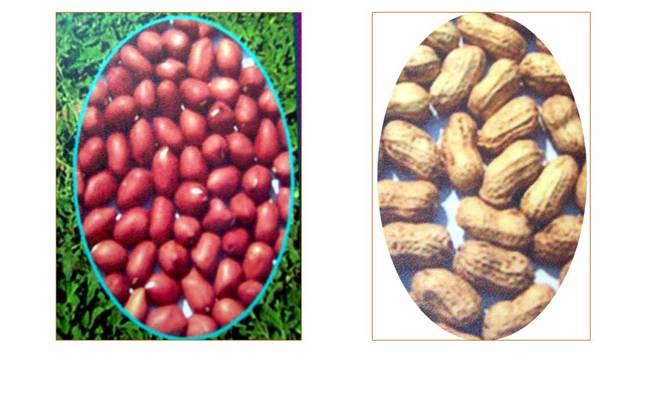
PARTICULARS OF GROUNDNUT VARIETIES
Particulars |
TMV 7 |
TMV 10 |
CO 3 |
COGn 4 |
COGn 5 |
Parentage |
Pureline selection from Tennessee white |
Spontaneous mutant from Argentina |
Derivative of
VG 55 x JL 24 |
Derivative of
TMV 10 x ICGV 82 |
Multiple cross derivative |
Duration (days) |
100 - 105 |
120 - 130 |
115-120 |
115-120 |
125-130 |
Average yield of pods kg/ha |
1400 |
1650 |
1950 |
2150 |
1850 |
Shelling % |
74 |
77 |
70 |
70 |
70 |
100 seed wt (g) |
36 |
43 |
65 |
60 |
47 |
Oil content % |
49.6 |
54.4 |
49.2 |
52.7 |
51 |
Special features |
Seed dormancy for 10 days |
Yield, oil, shelling high |
Bold 1-2 seeded, HPS kernels. Low bud necrosis incidence |
Bold pods;
1-2 seeded; high oil content. |
Dark green foliage; Tolerant to foliar diseases |
Growth habit |
Bunch |
Semi-spreading |
Bunch |
Bunch |
Semispreading |
Leaf colour |
Green |
Dark green |
Green |
Dark green |
Dark green |
Seed colour |
Light rose |
Red blotched with white |
Rose |
Rose |
Red testa |
Particulars |
ALR 3 |
VRI 2 |
VRI 3 |
VRIGn 5 |
Parentage |
Derivative of
(R33-1 x ICGV 68) x (NCAC 17090 x ALR 1) |
JL24 x CO2 |
J11 x R 33-1 |
Derivative of
CG 26 x ICGS 44 |
Duration(days) |
110-115 |
100 - 105 |
90 |
105 -110 |
Average yield of pods (kg/ha) |
2095 |
2060 |
1882 |
2133 |
Shelling % |
69 |
74.8 |
73 |
75 |
100 Seed wt. (g) |
46 |
49.9 |
35 |
46 |
Oil content % |
50 |
48 |
48 |
51 |
Special features |
Suitable for rainfed, rust resistant, tolerant to late leaf spot. |
suitable for irrigated |
Suitable for intercropping |
High reproductive efficiency. Dormancy
45 days. |
Growth habit |
Bunch |
Bunch |
Bunch |
Bunch |
Leaf colour |
Dark green |
Ashy green |
Light green |
Dark green |
Seed colour |
Rose |
Light rose |
Light rose |
Red testa. |
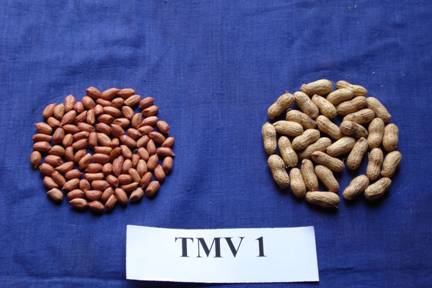
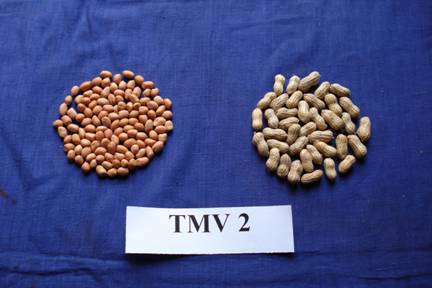
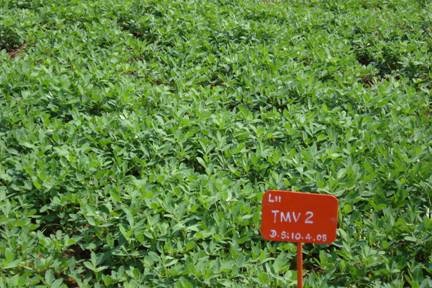


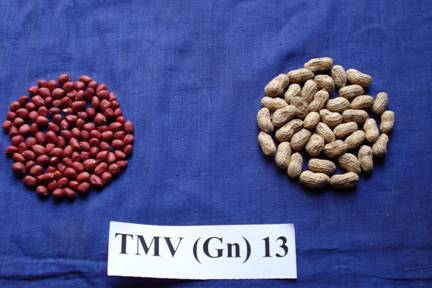
FIELD PREPARATION
i) Plough with tractor using a disc followed by harrow, once or twice with iron plough or 3 - 4 times with country plough till all the clods are broken and a fine tilth is obtained.
ii) Chiselling for soils with hard pan: Chisel the soils having hard pan formation at shallow depth with chisel plough first at 0.5 m interval in one direction and then in the direction perpendicular to the previous one, once in three years. Apply 12.5 t/ha FYM or composted coir pith besides chiseling.
iii) Amendments for soil surface crusting: a) to tide over the surface crusting, apply lime @ 2 t/ha along with FYM or composted coir pith @ 12.5 t/ha. b) When coir pith at 12.5 t/ha is converted into compost by inoculating with Pleurotus and applied, it serves as a good source of nutrient
2. APPLICATION OF FERTILIZERS
Apply NPK fertilizers as per soil test recommendation. If soil test is not done, follow the blanket recommendation.
|
N |
P |
K |
Sulphur sludge |
|
17 |
34 |
54 kg/ha |
60 kg/ha |
3. FORMING BEDS
- Form beds of size 10 m2 to 20 m2 depending upon the availability of water, slope of the land and type of soil.
- Wherever tractor is engaged, bed former may be used.
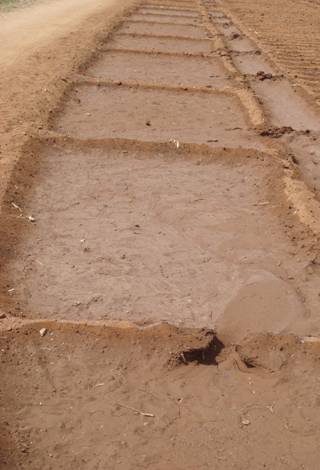
Form beds of size 10 m2 to 20 m2
4. POLYTHENE FILM MULCHING
Spread black polythene sheet over the soil surface. Seven micron polythene film sheet @50 kg/ha is required. Holes can be made at required spacing before spreading of the sheets.
 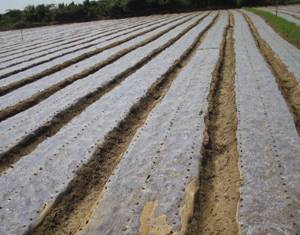
Polyethylene film mulch for irrigated groundnut
5. APPLICATION OF MICRONUTRIENTS
Mix 12.5 kg/ha of micronutrient mixture developed by Department of Agriculture with enough dry sand to make a total quantity of 50 kg/ha. Broadcast evenly on the soil surface immediately after sowing. Do not incorporate the micronutrient mixture to the soil.
6. NUTRITIONAL DISORDER
Zinc deficiency: Apply 25 kg ZnSO4/ha as basal.
If soil analysis shows less than 1.3 ppm of zinc, soil application of 25 kg ZnSo44 is recommended. For the standing crop, less than 39.4 ppm of zinc in leaves, foliar spray of 0.5% ZnSo44 is recommended.
Iron deficiency : spray 1% FeSO4 on 30, 40 and 50 days after sowing.
Boron deficiency: Apply Borax 10 kg + Gypsum 200 kg/ha at 45th day after sowing.
7. SEED RATE
Use 125 kg/ha of kernels. Increase the seed rate by 15% in the case of bold seeded varieties.
8. SPACING
Adopt a spacing of 30 cm between rows and 10 cm between plants. Wherever groundnut ring mosaic (bud necrosis) is prevalent, adopt a spacing of 15cm x 15 cm.
9. SEED TREATMENT
i) |
Treat the seeds with Trichoderma viride @ 4 g/kg seed or Pseudomonas fluorescens @ 10 g/kg seed. |
|
|
Biocontrol agents are compatible with biofertilizers. |
|
|
First treat the seeds with biocontrol agents and then with Rhizobium. |
|
|
Fungicides and biocontrol agents are incompatible. |
ii) |
Treatment with Trichoderma can be done just before sowing. SUCH SEEDS SHOULD NOT BE TREATED WITH FUNGICIDES. (or) |
iii) |
Treat the seeds with Thiram or Mancozeb @ 4 g/kg of seed or Carboxin or Carbendazim at 2 g/kg of seed. |
|
iv) |
Treat the seeds with 3 packets (600 g)/ha of Rhizobial culture TNAU14 developed at TNAU using rice kanji as binder. If the seed treatment is not carried out, apply 10 packets/ha (2000 g) with 25 kg of FYM and 25 kg of soil before sowing. |
Seed treatment will protect the young seedlings from root-rot and collar rot infection.
10. SOWING
- Dibble the seeds at 4 cm depth along with fertilizer.
11. WEED MANAGEMENT
i) Pre-sowing: Fluchloralin at 2.0 l/ha soil applied and incorporatede followed by light irrigation.
ii) Pre-emergence: Fluchloralin 2.0 l/ha applied through flat fan nozzle with 900 l of water/ha followed by irrigation. After 35 - 40 days one hand weeding may be given.
iii) If no herbicide is applied two hand hoeing and weeding are given on 20th and 40th day after sowing.
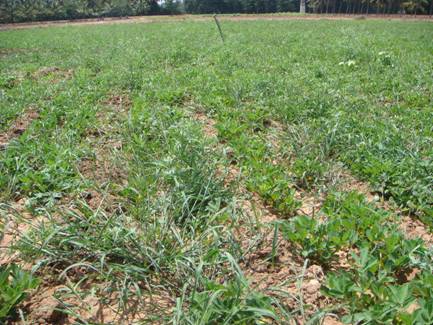
Unweeded groundnut field

Weed free groundnut field
Source: www.icrisat.org
12. EARTHING UP:
Accomplish earthing up during second hand weeding/late hand weeding (in erbicide application).
NOTE: i) Earthing up provides medium for the peg development. ii) Use the improved hoe with long handle which can be worked more efficiently in a standing position. iii) Do not disturb the soil after the 45th day of sowing as it will affect pod formation adversely.
13. APPLICATION OF CALCIUM SULPHATE (GYPSUM)
- Apply gypsum @ 400 kg/ha by the side of the plants on the 40th to 45th day of sowing. Apply gypsum, hoe and incorporate in the soil and then earth up.
- Avoid gypsum in calciferous soils.
- Gypsum is effective in soils deficient in calcium and sulphur.
NOTE: Application of gypsum encourages pod formation and better filling up of the pods.
Application of gypsum at the rate of 50 % basal both in rainfed and irrigated condition reduces Khadhasty malady and pod scab nematode
Combined nutrient spray
Pod filling is a major problem especially in the bold seed varieties. To improve pod filling spraying of nutrient solution is to be given. This can be prepared by soaking DAP 2.5 kg, Ammonium sulphate 1 kg and borax 0.5 kg in 37 lit of water overnight. The next day morning it can be filtered and about 32 litre of mixture can be obtained and it may be diluted with 468 lit of water so as to made up to 500 litre to spray for one ha. Plano fix at the rate of 350 ml. can also be mixed while spraying. This can be sprayed on 25th and 35th day after sowing.
14. WATER MANAGEMENT
Schedule the irrigation at 0.40 and 0.60 IW/CPE ratio during vegetative and reproductive phases respectively. Regulate irrigation according to the following growth phase of the crop.
Pre-flowering phase : 1 to 25 days
Flowering phase : 26 to 60 days
Maturity phase : 61 to 105 days
Regulate irrigation based on physiological growth phases. Pegging, flowering and pod development phases are critical for irrigation during which period adequate soil moisture is essential. Apply irrigation as follows:
- Sowing or pre-sowing
- Life irrigation, 4 - 5 days after sowing if sowing irrigation given to break the surface crust.
- 20 days after sowing
- At flowering give two irrigations
- At pegging stage give one or two irrigations
vi) In pod development stage, 2 - 3 irrigations depending on the soil type
Note: Spraying 0.5% Potassium chloride during flowering and pod development stages will aid to mitigate the ill effects of water stress. Sprinkler irrigation will save water to the tune of about 30%. Borderstrip irrigation is recommended in command areas in light textured soils. Composted coir pith increases moisture availability and better drainage in heavy textured soil.
15. HARVESTING
- Observe the crop, considering its average duration. Drying and falling of older leaves and yellowing of the top leaves indicate maturity.
- Pull out a few plants at random and shell the pods. If the inner shell is brownish black and not white, then the crop has matured.
- Irrigate prior to harvest, if the soil is dry, as this will facilitate easy harvesting. If there is enough moisture in the soil, there is no need for irrigation for harvesting.
- If water is not available for irrigating the field prior to harvest, work a mould board plough or work a country plough, so that the plants are uprooted. Engage labour to search pods left out in the soil, if necessary.
NOTE: Do not keep the pulled out plants in heaps when they are wet, especially the bunch varieties, as the pods will start sprouting.
v) Strip off the pods from the plants. Groundnut stripper developed by TNAU can be used.
vi) Dry the pods in the sun for 4 or 5 days. Repeat drying for 2 or 3 more days after an interval of 2 or 3 days to ensure complete drying. When temperature is very high, avoid direct sun drying. Collect the pods in gunnies and store on the ground over a layer of sand to avoid any moisture coming in contact with dry pods.

Seedling emerge at 5-10 days
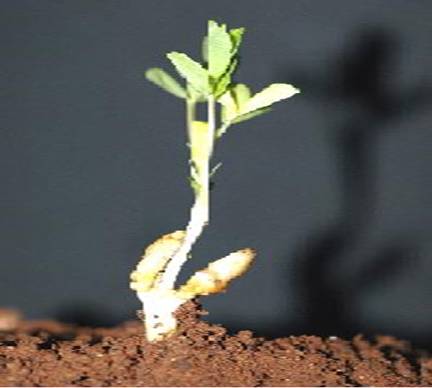
Seedling emergence stage
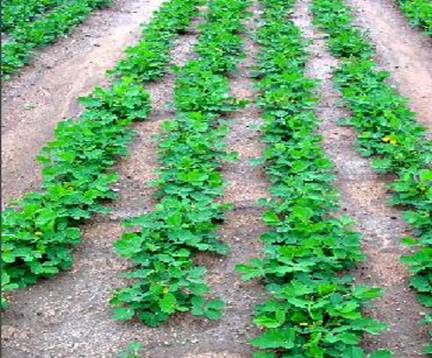
Flowering stage

Pegging stage
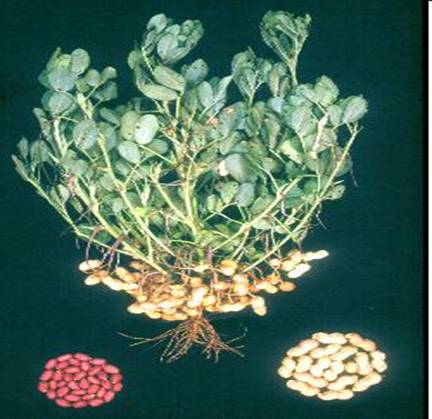
Maturity stage
Source: www.test1.icrisat.org
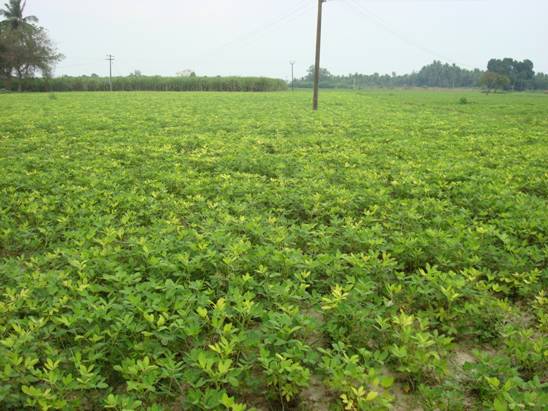
GROUNDNUT (Arachis hypogaea )
CROP MANAGEMENT
I. Rainfed
1. FIELD PREPARATION
i) Plough with tractor using a disc followed by harrow, once or twice with iron plough or
3 - 4 times with country plough till all the clods are broken and a fine tilth is obtained.
ii) Chiselling for soils with hard pan: Chisel the soils having hard pan formation at shallow depth with chisel plough first at 0.5 m interval in one direction and then in the direction perpendicular to the previous one, once in three years. Apply 12.5 t/ha of FYM or composted coir pith besides chiselling.
- Amendments for soil surface crusting: a) To tide over the surface crusting, apply lime @ 2 t/ha along with FYM or composted coir pith @ 12.5 t/ha. b) Coir pith at 12.5 t/ha converted to compost by inoculating with Pleurotus and applied serves as a good source of nutrients.
2. APPLICATION OF FERTILIZERS
Apply NPK fertilizers as per soil test recommendation. If soil test is not done, follow the blanket recommendation.
3. FORMING BEDS
- Form beds of size 10 m2 to 20 m2 depending upon the slope of the land and type of soil.
- Wherever tractor is engaged, bed former may be used.
4. APPLICATION OF MICRONUTRIENTS
Mix 12.5 kg/ha of micronutrient mixture developed by Department of Agriculture with enough dry sand to make a total quantity of 50 kg/ha. Broadcast evenly on the soil surface immediately after sowing. Do not incorporate micronutrient mixture in to the soil.
5. NUTRITIONAL DISORDER
Zinc deficiency: Apply 25 kg ZnSO4/ha as basal.
If soil analysis shows less than 1.3 ppm of zinc, soil application of 25 kg ZnSo44 is recommended. For the standing crop, less than 39.4 ppm of zinc in leaves, foliar spray of 0.5% ZnSo44 is recommended.
Iron deficiency: spray 1% FeSo4 on 30, 40 and 50 days after sowing.
Boron deficiency: Apply Borax 10 kg + Gypsum 400 kg/ha at 45th day after sowing.
6. SEED RATE
Use 120 kg/ha of kernels. Increase the seed rate by 15% in the case of bold seeded varieties.
7. SPACING
Adopt a spacing of 30 cm between rows and 10 cm between plants. Wherever groundnut ring mosaic (bud necrosis) is prevalent, adopt a spacing of 15cm x 15 cm.
8. SEED TREATMENT
i) |
Treat the seeds with talc formulation of Trichoderma viride @ 4 g/kg seed or Pseudomonas fluorescens @ 10 g/kg seed. |
|
|
Biocontrol agents are compatible with biofertilizers. |
|
|
Treat the seeds with biocontrol agents first and then with Rhizobium. |
|
|
Fungicides and biocontrol agents are incompatible. |
ii) |
Treat the seeds with Trichoderma @ 4g/kg. This can be done just before sowing. It is compatible with biofertilizers. SUCH SEEDS SHOULD NOT BE TREATED WITH FUNGICIDES (or) |
iii) |
Treat the seeds with Thiram or Mancozeb @ 4 g/kg of seed or Carboxin or Carbendazim at 2 g/kg of seed. |
|
iv) |
Treat the seeds with 3 packets (600 g)/ha of Rhizobialculture TNAU14 + 3 packets of Azospirillum (600 g/ha) and 3 packets(600 g/ha) of Phosphobacteria or 6 packets of Azophos(1200 g/ha)developed at TNAU using rice kanji as binder. If the seed treatment is not carried out apply 10packets of Rhizobium (2000g/ha) + 10 packets of Azospirillum (2000 g/ha) and 10 packets(2000 g) of Phosphobacteria with 25 kg of FYM and 25 kg of soil before sowing. |
9. SOWING
- Use Kovai seed drill/gorru to sow the seeds in lines.
- Put one seed in each hole. Protect the seeds from crows and squirrels.
10. INTERCROPPING
- Raise one row of cowpea for every five rows of groundnut wherever red hairy caterpillar is endemic.
- Raise intercrops like redgram, blackgram, sunflower, gingelly or other pulses.
- Cumbu can be raised as intercrop.
- Groundnut + Gingelly or Groundnut + Blackgram in the ratio of 4:1 or Groundnut + Cowpea at 6:1 ratio and Groundnut + Sunflower at 6:2 ratio may be raised.
11. WEED MANAGEMENT
- Pre-sowing: Fluchloralin at 2.0 l/ha soil applied and incorporated.
- Pre-emergence: Fluchloralin 2.0 l/ha applied through flat fan nozzle with 900 l of water/ha followed by irrigation. After 35 - 40 days one hand weeding may be given.
- If no herbicide is applied two hand weeding and hoeing are given on 20th and 40th day after sowing.
12. EARTHING UP
Accomplish earthing up during second hand weeding/late hand weeding (in herbicide application).
NOTE: i) Earthing up provides medium for the peg development ii) Use the improved hoe with long handle which can be worked more efficiently in a standing position. iii) Do not disturb the soil after 45th day of sowing as it will affect pod formation adversely.
13. APPLICATION OF CALCIUM SULPHATE (GYPSUM)
- Apply gypsum @ 400 kg/ha by the side of the plants on 40th to 70th day depending upon soil moisture.
- Apply gypsum, hoe and incorporate it in the soil and then earth up.
- Avoid gypsum in calciferous soils.
- Gypsum is effective in soils deficient in calcium and sulphur.
NOTE: Application of gypsum encourages pod formation and better filling up of the pods.
Application of gypsum at the rate of 50 % basal both in rainfed and irrigated condition reduces Khadhasty malady and pod scab nematode
Combined nutrient spray
Pod filling is a major problem especially in the bold seed varieties. To improve pod filling spraying of nutrient solution is to be given. This can be prepared by soaking DAP 2.5 kg, Ammonium sulphate 1 kg and borax 0.5 kg in 37 lit of water overnight. The next day morning it can be filtered and about 32 litre of mixture can be obtained and it may be diluted with 468 lit of water so as to made up to 500 litre to spray for one ha. Plano fix at the rate of 350 ml. can also be mixed while spraying. This can be sprayed on 25th and 35th day after sowing.
14. HARVESTING
- Observe the crop, considering its average duration. Drying and falling of older leaves and yellowing of the top leaves indicate maturity.
- Pull out a few plants at random and shell the pods. If the inner shell is brownish black and not white, then the crop has matured.
- Irrigate prior to harvest, if the soil is dry, as this will facilitate easy harvesting. If there is enough moisture in the soil, there is no need for irrigation for harvesting.
- If water is not available for irrigating the field prior to harvest, work a mould board plough or work a country plough, so that the plants are uprooted. Engage labour to search pods left out in the soil, if necessary.
NOTE: Do not keep the pulled out plants in heaps when they are wet, especially the bunch varieties, as the pods will start sprouting.
v) Strip off the pods from the plants. Groundnut stripper developed by TNAU can be used.
vi) Dry the pods in the sun for 4 or 5 days. Repeat drying for 2 or 3 more days after an interval of 2 or 3 days to ensure complete drying. When temperature is very high, avoid direct sun drying. Collect the pods in gunnies and store on the ground over a layer of sand to avoid any moisture coming in contact with dry pods.
I. Rainfed
1. FIELD PREPARATION
i) Plough with tractor using a disc followed by harrow, once or twice with iron plough or
3 - 4 times with country plough till all the clods are broken and a fine tilth is obtained.
ii) Chiselling for soils with hard pan: Chisel the soils having hard pan formation at shallow depth with chisel plough first at 0.5 m interval in one direction and then in the direction perpendicular to the previous one, once in three years. Apply 12.5 t/ha of FYM or composted coir pith besides chiselling.
- Amendments for soil surface crusting: a) To tide over the surface crusting, apply lime @ 2 t/ha along with FYM or composted coir pith @ 12.5 t/ha. b) Coir pith at 12.5 t/ha converted to compost by inoculating with Pleurotus and applied serves as a good source of nutrients.
2. APPLICATION OF FERTILIZERS
Apply NPK fertilizers as per soil test recommendation. If soil test is not done, follow the blanket recommendation.
3. FORMING BEDS
- Form beds of size 10 m2 to 20 m2 depending upon the slope of the land and type of soil.
- Wherever tractor is engaged, bed former may be used.
4. APPLICATION OF MICRONUTRIENTS
Mix 12.5 kg/ha of micronutrient mixture developed by Department of Agriculture with enough dry sand to make a total quantity of 50 kg/ha. Broadcast evenly on the soil surface immediately after sowing. Do not incorporate micronutrient mixture in to the soil.
5. NUTRITIONAL DISORDER
Zinc deficiency: Apply 25 kg ZnSO4/ha as basal.
If soil analysis shows less than 1.3 ppm of zinc, soil application of 25 kg ZnSo44 is recommended. For the standing crop, less than 39.4 ppm of zinc in leaves, foliar spray of 0.5% ZnSo44 is recommended.
Iron deficiency: spray 1% FeSo4 on 30, 40 and 50 days after sowing.
Boron deficiency: Apply Borax 10 kg + Gypsum 400 kg/ha at 45th day after sowing.
6. SEED RATE
Use 120 kg/ha of kernels. Increase the seed rate by 15% in the case of bold seeded varieties.
7. SPACING
Adopt a spacing of 30 cm between rows and 10 cm between plants. Wherever groundnut ring mosaic (bud necrosis) is prevalent, adopt a spacing of 15cm x 15 cm.
8. SEED TREATMENT
i) |
Treat the seeds with talc formulation of Trichoderma viride @ 4 g/kg seed or Pseudomonas fluorescens @ 10 g/kg seed. |
|
|
Biocontrol agents are compatible with biofertilizers. |
|
|
Treat the seeds with biocontrol agents first and then with Rhizobium. |
|
|
Fungicides and biocontrol agents are incompatible. |
ii) |
Treat the seeds with Trichoderma @ 4g/kg. This can be done just before sowing. It is compatible with biofertilizers. SUCH SEEDS SHOULD NOT BE TREATED WITH FUNGICIDES (or) |
iii) |
Treat the seeds with Thiram or Mancozeb @ 4 g/kg of seed or Carboxin or Carbendazim at 2 g/kg of seed. |
|
iv) |
Treat the seeds with 3 packets (600 g)/ha of Rhizobialculture TNAU14 + 3 packets of Azospirillum (600 g/ha) and 3 packets(600 g/ha) of Phosphobacteria or 6 packets of Azophos(1200 g/ha)developed at TNAU using rice kanji as binder. If the seed treatment is not carried out apply 10packets of Rhizobium (2000g/ha) + 10 packets of Azospirillum (2000 g/ha) and 10 packets(2000 g) of Phosphobacteria with 25 kg of FYM and 25 kg of soil before sowing. |
9. SOWING
- Use Kovai seed drill/gorru to sow the seeds in lines.
- Put one seed in each hole. Protect the seeds from crows and squirrels.
10. INTERCROPPING
- Raise one row of cowpea for every five rows of groundnut wherever red hairy caterpillar is endemic.
- Raise intercrops like redgram, blackgram, sunflower, gingelly or other pulses.
- Cumbu can be raised as intercrop.
- Groundnut + Gingelly or Groundnut + Blackgram in the ratio of 4:1 or Groundnut + Cowpea at 6:1 ratio and Groundnut + Sunflower at 6:2 ratio may be raised.
11. WEED MANAGEMENT
- Pre-sowing: Fluchloralin at 2.0 l/ha soil applied and incorporated.
- Pre-emergence: Fluchloralin 2.0 l/ha applied through flat fan nozzle with 900 l of water/ha followed by irrigation. After 35 - 40 days one hand weeding may be given.
- If no herbicide is applied two hand weeding and hoeing are given on 20th and 40th day after sowing.
12. EARTHING UP
Accomplish earthing up during second hand weeding/late hand weeding (in herbicide application).
NOTE: i) Earthing up provides medium for the peg development ii) Use the improved hoe with long handle which can be worked more efficiently in a standing position. iii) Do not disturb the soil after 45th day of sowing as it will affect pod formation adversely.
13. APPLICATION OF CALCIUM SULPHATE (GYPSUM)
- Apply gypsum @ 400 kg/ha by the side of the plants on 40th to 70th day depending upon soil moisture.
- Apply gypsum, hoe and incorporate it in the soil and then earth up.
- Avoid gypsum in calciferous soils.
- Gypsum is effective in soils deficient in calcium and sulphur.
NOTE: Application of gypsum encourages pod formation and better filling up of the pods.
Application of gypsum at the rate of 50 % basal both in rainfed and irrigated condition reduces Khadhasty malady and pod scab nematode
Combined nutrient spray
Pod filling is a major problem especially in the bold seed varieties. To improve pod filling spraying of nutrient solution is to be given. This can be prepared by soaking DAP 2.5 kg, Ammonium sulphate 1 kg and borax 0.5 kg in 37 lit of water overnight. The next day morning it can be filtered and about 32 litre of mixture can be obtained and it may be diluted with 468 lit of water so as to made up to 500 litre to spray for one ha. Plano fix at the rate of 350 ml. can also be mixed while spraying. This can be sprayed on 25th and 35th day after sowing.
14. HARVESTING
- Observe the crop, considering its average duration. Drying and falling of older leaves and yellowing of the top leaves indicate maturity.
- Pull out a few plants at random and shell the pods. If the inner shell is brownish black and not white, then the crop has matured.
- Irrigate prior to harvest, if the soil is dry, as this will facilitate easy harvesting. If there is enough moisture in the soil, there is no need for irrigation for harvesting.
- If water is not available for irrigating the field prior to harvest, work a mould board plough or work a country plough, so that the plants are uprooted. Engage labour to search pods left out in the soil, if necessary.
NOTE: Do not keep the pulled out plants in heaps when they are wet, especially the bunch varieties, as the pods will start sprouting.
v) Strip off the pods from the plants. Groundnut stripper developed by TNAU can be used.
vi) Dry the pods in the sun for 4 or 5 days. Repeat drying for 2 or 3 more days after an interval of 2 or 3 days to ensure complete drying. When temperature is very high, avoid direct sun drying. Collect the pods in gunnies and store on the ground over a layer of sand to avoid any moisture coming in contact with dry pods.
|



















